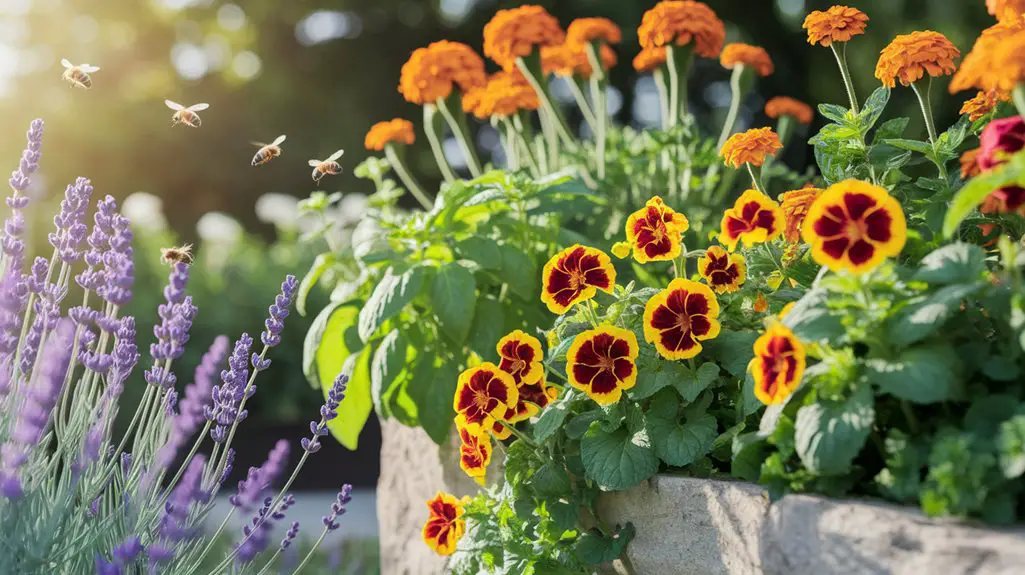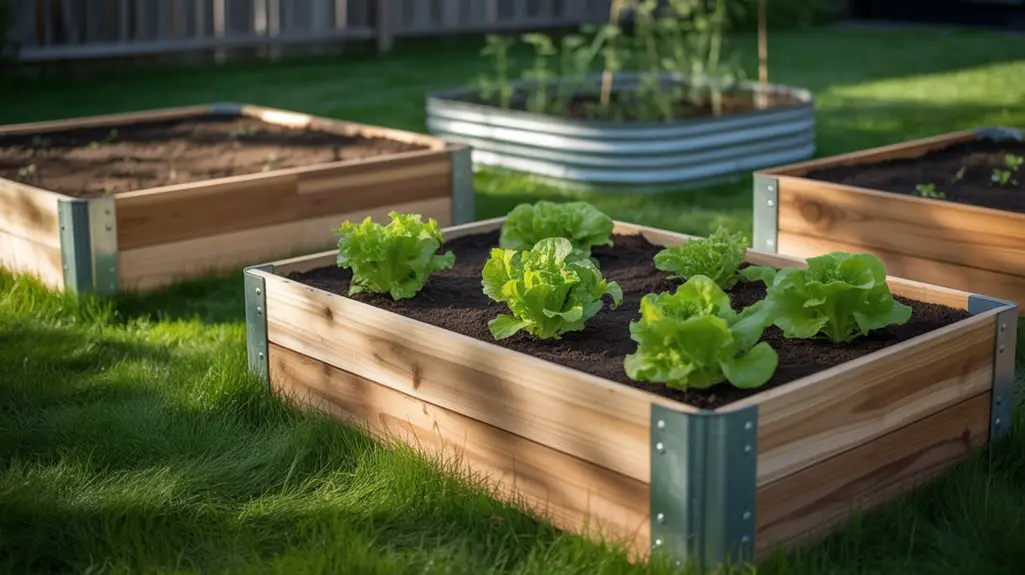Like sentinels in an ecological fortress, plants can be your most reliable allies against garden invaders. You’ll find that strategic placement of species like Thymus vulgaris and Achillea millefolium creates microclimates hostile to pest populations while attracting beneficial predatory insects. The biochemical compounds these plants produce—particularly terpenes and phenolic acids—disrupt pest feeding patterns and reproductive cycles. Discover how these botanical defenders can transform your garden’s ecosystem without synthetic interventions.
Aromatic Herbs That Naturally Repel Garden Pests
Phytochemicals provide the foundation for natural pest management in garden ecosystems. These secondary metabolites, particularly terpenes and phenolic compounds found in Lamiaceae family members, function as powerful allelochemical deterrents against numerous arthropod pests.
You’ll find Thymus vulgaris (thyme) and Rosmarinus officinalis (rosemary) particularly effective against Lepidoptera larvae due to their volatile monoterpenes. Mentha species exude menthol that disrupts neuroreceptors in Aphidoidea populations.
For subterranean protection, Allium sativum’s organosulfur compounds repel Nematoda effectively when intercropped with susceptible Solanaceae.
Position these botanical deterrents strategically using integrated spatial arrangements: border plantings create protective aromatic barriers while companion configurations maximize interspecies defensive synergies. The trichomes present on Ocimum basilicum leaves offer additional mechanical protection against soft-bodied Hemiptera. Additionally, certain natural herbs have been shown to enhance the overall health of the garden ecosystem by attracting beneficial insects.
Flowering Plants That Attract Beneficial Insects

While phytochemical deterrents provide direct pest management benefits, strategic implementation of insectary plants creates multifunctional ecological infrastructure within cultivation systems.
You’ll maximize biological control agents by selecting species that produce abundant nectar and pollen resources, supporting predator and parasitoid populations throughout their lifecycles.
- *Achillea millefolium* (yarrow) attracts syrphid flies whose larvae consume aphids
- *Coriandrum sativum* (cilantro) flowers support parasitic wasps targeting lepidopteran pests
- *Lobularia maritima* (sweet alyssum) maintains Orius species for thrips suppression
- *Fagopyrum esculentum* (buckwheat) provides habitat for Coccinellidae and Chrysopidae
- *Phacelia tanacetifolia* enhances Hymenoptera diversity for thorough biocontrol
Interplanting these flowering taxa throughout your cultivation space creates persistent refugia for beneficial arthropods, reducing pest outbreaks through trophic cascades while minimizing chemical intervention requirements. Additionally, natural solutions can further enhance the effectiveness of these plant strategies by providing alternative pest deterrents.
Companion Planting Strategies for Pest Management

Companion planting represents a sophisticated polyculture approach that harnesses interspecific biochemical interactions to modify pest behavior and population dynamics.
You’ll maximize protection by strategically positioning Allium spp. adjacent to Brassica crops to repel Pieris rapae larvae through sulfur compound volatilization.
For ideal Lepidoptera management, integrate Tagetes spp. with Solanum lycopersicum to suppress nematode populations via thiophene release from root exudates.
Implement trap cropping using Tropaeolum majus near Cucurbitaceae to divert Acalymma vittatum infestations.
You can further enhance semiochemical diversity by establishing Lamiaceae species—particularly Nepeta cataria and Mentha spicata—which emit terpenoids that disrupt host-finding behaviors of numerous Hemiptera and Thysanoptera pests common in agricultural systems. Additionally, utilizing natural pest control methods can significantly reduce reliance on chemical pesticides, fostering a healthier garden ecosystem.
Low-Maintenance Perennials for Long-Term Pest Control
Establishing resilient perennial systems offers substantial advantages for sustained pest management through consistent production of allelopathic and repellent compounds.
You’ll find these plants require minimal intervention while providing year-after-year protection against common garden pests.
Key perennials for integrated pest management include:
- *Tanacetum vulgare* (Tansy) – Contains pyrethrin compounds that deter ants, cucumber beetles, and squash bugs
- *Nepeta cataria* (Catnip) – Repels aphids, flea beetles, and Japanese beetles via nepetalactone
- *Achillea millefolium* (Yarrow) – Attracts parasitoid wasps while deterring aphids through volatile phenolic compounds
- *Lavandula angustifolia* (Lavender) – Emits terpenes toxic to Diptera larvae and repels moths
- *Monarda spp.* (Bee Balm) – Contains thymol that inhibits fungal pathogens and deters herbivorous insects
These xerophytic-adapted species thrive in diverse edaphic conditions, creating ecological refugia for beneficial arthropods while establishing defensive biochemical barriers. Additionally, incorporating natural pest solutions into your gardening practices can enhance the overall health of your plants and soil.
Edible Plants That Double as Pest Deterrents
Many cultivated edible species synthesize bioactive allelochemicals that function both as culinary compounds and potent arthropod deterrents.
Allium sativum (garlic) contains allicin and diallyl disulfide that repel Lepidoptera larvae and Hemiptera species.
Ocimum basilicum (basil) produces linalool and eugenol, effective against Aphis spp. and Tetranychus urticae.
You’ll find Thymus vulgaris (thyme) particularly valuable; its thymol disrupts neurotransmission in Coleoptera.
Nepeta cataria (catnip) contains nepetalactone, repelling Culicidae with 10× effectiveness versus DEET.
Anethum graveolens (dill) attracts beneficial Syrphidae while its apiole deters Pieris rapae.
For companion planting, integrate Tagetes patula (French marigold) near Solanum lycopersicum; the thiophenes released inhibit root-knot nematodes while providing edible flowers with antioxidant properties. Additionally, employing effective pest control methods enhances the overall health and productivity of your garden.
Conclusion
By integrating these biodiverse plant taxa into your garden ecosystem, you’re creating a complex trophic network that naturally suppresses phytophagous insect populations. Research shows gardens with companion-planted Asteraceae and Lamiaceae families experience up to 60% reduction in pest pressure compared to monoculture plots. Maximize this ecological service by positioning aromatic deterrents alongside susceptible crops and establishing permanent refugia for predatory arthropods—transforming your garden into a self-regulating, sustainable habitat.




